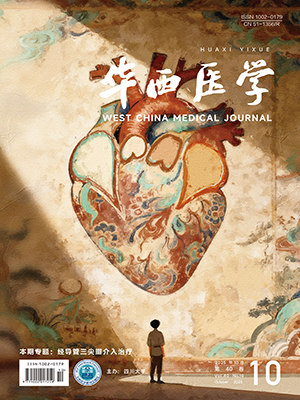【摘要】 目的 研究两种不同的衰减系数转换方法对正电子发射计算机断层显像/计算机体层扫描(PET/CT) 标准摄取值(SUV)测量值的影响。 方法 2009年11-12月,从经过PET/CT氟代脱氧葡萄糖(FDG)显像患者中选取20例,其口腔中均有金属假牙。以四段转换法和二段转换法重建全身衰减校正断层图像。分别选取3种高密度区域和7种低密度区域,测量其最大SUV和平均SUV,比较两种转换方法SUV测量值。 结果 平均SUV:二段转换法的3种高密度区域SUV降低,在7种低密度区域中,1种区域增高,1种区域降低(P值均 lt;0.05)。最大SUV:二段转换法的2种高密度区域的SUV降低,在7种低密度区域中,1种区域增高,2种靠近高密度组织的区域降低(P值均 lt;0.05)。 结论 二段转换法能降低高密度区域的SUV,可用于减小体内金属植入物和CT对比剂造成的过度校正。
【Abstract】 Objective To explore the effect of two attenuation correction algorithms on PET/CT SUV measurement. Methods From November to December 2009, the PET Slice of 20 patients with metallic dental implant were reconstructed with four-and two-section algorithms respectively. Mean SUV and maximum SUV were measured in three high-density areas and 7 low-density areas. Paired t test were performed to compare the differences. Results Mean SUV: two-section algorithm produced significantly lower SUV in all the three high-density areas; in the 7 low-density areas, SUV increased obviously in one area and decreased apparently in one area (P lt;0.05). Maximum SUV: two-section algorithm produced significantly lower SUV in two high-density areas, SUV increased obviously in one area and decreased apparently in two areas which was adjacent to the high density areas (P lt;0.05). Conclusion Two-section algorithm produces lower SUV measurement value than the four-section algorithm does, and it is useful in PET/CT studies for patients with metallic dental implant and when CT contrast is used.
Citation: YANG Xiaochuan,ZHOU Lyi. Effect of Different Attenuation Coefficient Transformation Algorithms on PET/CT SUV Measurement. West China Medical Journal, 2010, 25(11): 2052-2054. doi: Copy
Copyright © the editorial department of West China Medical Journal of West China Medical Publisher. All rights reserved




